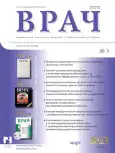Differential diagnosis for urinary stones of different chemical composition, by using dual energy computed tomography
- 作者: Ryazanov V.1, Kutsenko V.1, Sadykova G.1, Menshikova S.1, Seliverstov P.2, Bagnenko S.1,2, Nikolaev A.1, Postanogov R.1, Libert A.1
-
隶属关系:
- Saint Petersburg State Pediatric Medical University, Ministry of Health of Russia
- S.M. Kirov Military Medical Academy
- 期: 卷 34, 编号 3 (2023)
- 页面: 43-48
- 栏目: For Diagnosis
- URL: https://journals.eco-vector.com/0236-3054/article/view/364521
- DOI: https://doi.org/10.29296/25877305-2023-03-08
- ID: 364521
如何引用文章
详细
The use of dual energy computed tomography (DECT) has become widespread in urology, including in the diagnosis of urolithiasis. DECT makes it possible to visualize and differentiate urinary stones of different chemical density and composition from each other. Studies have shown the advantages of DECT not only in the detection, but also in the differentiation of the main groups of urinary stones. At the same time, a number of in vivo studies evaluate DECT as a technique for the high-accuracy differential diagnosis of urate stones. The accuracy of diagnosing urate stones with DECT reaches 92-100%, as confirmed by sensitivity (84.6-98.4%) and specificity (100%).
全文:
作者简介
V. Ryazanov
Saint Petersburg State Pediatric Medical University, Ministry of Health of Russia
编辑信件的主要联系方式.
Email: val9126@mail.ru
MD
俄罗斯联邦, Saint PetersburgV. Kutsenko
Saint Petersburg State Pediatric Medical University, Ministry of Health of Russia
Email: val9126@mail.ru
Candidate of Medical Sciences
俄罗斯联邦, Saint PetersburgG. Sadykova
Saint Petersburg State Pediatric Medical University, Ministry of Health of Russia
Email: val9126@mail.ru
Candidate of Medical Sciences
俄罗斯联邦, Saint PetersburgS. Menshikova
Saint Petersburg State Pediatric Medical University, Ministry of Health of Russia
Email: val9126@mail.ru
俄罗斯联邦, Saint Petersburg
P. Seliverstov
S.M. Kirov Military Medical Academy
Email: val9126@mail.ru
Candidate of Medical Sciences
俄罗斯联邦, Saint PetersburgS. Bagnenko
Saint Petersburg State Pediatric Medical University, Ministry of Health of Russia; S.M. Kirov Military Medical Academy
Email: val9126@mail.ru
MD
俄罗斯联邦, Saint Petersburg; Saint PetersburgA. Nikolaev
Saint Petersburg State Pediatric Medical University, Ministry of Health of Russia
Email: val9126@mail.ru
俄罗斯联邦, Saint Petersburg
R. Postanogov
Saint Petersburg State Pediatric Medical University, Ministry of Health of Russia
Email: val9126@mail.ru
俄罗斯联邦, Saint Petersburg
A. Libert
Saint Petersburg State Pediatric Medical University, Ministry of Health of Russia
Email: val9126@mail.ru
俄罗斯联邦, Saint Petersburg
参考
- Zueva L.F., Kapsargin F.P., Simonov K.V. Metaphylaxis of kidney stones based on component composition detected by DECT and CE methods. Medicine and High Technology. 2020; 1: 55–67 (in Russ.).
- Kapanadze L.B., Serova N.S., Rudenko V.I., et al. Experience of using dual-energy computed tomography in patient with urolithiasis. Medical Visualization. 2018; 4: 59–64 (in Russ.). doi: 10.24835/1607-0763-2018-4-59-64
- Kapanadze L.B., Serova N.S., Rudenko V.I. et al. Results of application of dual-energy computed tomography in the diagnosis of urolithiasis. REJR. 2018; 8 (2): 94–104 (in Russ.). doi: 10.21569/2222-7415-2018-8-2-94-104
- Nazarov T.K., Rychkov I.V., Lebedev D.G., Trubnikova K.E. Comparative analysis of data from a dual-energy computer tomograph and the results of a mineralogical research of urinary stones. Diagnostic radiology and radiotherapy. 2018; 2: 54–8 (in Russ.). doi: 10.22328/2079-5343-2018-9-2-54-58
- Lopatkin N.A. Urology. Ed. N.A. Lopatkina. M.: GEOTAR-Media, 2011; 1024 s. (in Russ.).
- Appel E., Thomas C., Steuwe A. et al. Evaluation of split-filter dual-energy CT for characterization of urinary stones. Br J Radiol. 2021; 94 (1127): 20210084. doi: 10.1259/bjr.20210084
- Erdogan H., Temizoz O., Koplay M. et al. In Vivo Analysis of Urinary Stones With Dual-Energy Computed Tomography. J Comput Assist Tomogr. 2019; 43 (2): 214–9. doi: 10.1097/RCT.0000000000000831
- McGrath T.A., Frank R.A., Schieda N. et al. Diagnostic accuracy of dual-energy computed tomography (DECT) to differentiate uric acid from non-uric acid calculi: systematic review and meta-analysis. Eur Radiol. 2020; 30: 2791–801. doi: 10.1007/s00330-019-06559-0
- Nourian A., Ghiraldi E., Friedlander J.I. Dual-Energy CT for Urinary Stone Evaluation. Curr Urol Rep. 2021; 22 (1): 1. doi: 10.1007/s11934-020-01019-5
- Ogawa N., Sato S., Ida K. et al. Evaluation of Urinary Stone Composition and Differentiation between Urinary Stones and Phleboliths Using Single-source Dual-energy Computed Tomography. Acta Med Okayama. 2017; 71 (2): 91–6. doi: 10.18926/AMO/54976
- Rompsaithong U., Jongjitaree K., Korpraphong P. et al. Characterization of renal stone composition by using fast kilovoltage switching dual-energy computed tomography compared to laboratory stone analysis: a pilot study. Abdom Radiol. 2019; 44: 1027–32. doi: 10.1007/s00261-018-1787-6
- Shalini S., Kasi Arunachalam V., Kumar Varatharajaperumal R. et al. The role of third-generation dual-source dual-energy computed tomography in characterizing the composition of renal stones with infrared spectroscopy as the reference standard. Pol J Radiol. 2022; 87 (1): 172–6. doi: 10.5114/pjr.2022.114841
补充文件








